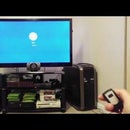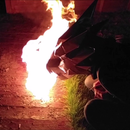Introduction: Custom Designed Durable and Functional Duct Tape Wallet
How to make a stylish yet functional Gaffer/Duct Tape Wallet that will last until you get bored of it because mine is 5 years old and has not broken yet and is showing no signs of giving up.
This Instructable will help you make your own personalised wallet including card holders, coin partition and pen holder. These wallets are very durable and should last for as long as you need them too mine has lasted five years so far and my brothers even longer. If something does go wrong and a piece does peel off then all you need to do to repair it is put a new piece of tape over the part that came off. good as new!
The silver one with the pen holder is an exact copy of my old high quality expensive leather wallet that broke after 6 months, the duct tape replacement lasted 10 times longer and is still going.
These wallets are also good conversation points as people are always commenting on them ether because they are impressed it is made out of tape and not just an old wallet covered in tape or because of the miniature pen which is very useful.
This Instructable will help you make your own personalised wallet including card holders, coin partition and pen holder. These wallets are very durable and should last for as long as you need them too mine has lasted five years so far and my brothers even longer. If something does go wrong and a piece does peel off then all you need to do to repair it is put a new piece of tape over the part that came off. good as new!
The silver one with the pen holder is an exact copy of my old high quality expensive leather wallet that broke after 6 months, the duct tape replacement lasted 10 times longer and is still going.
These wallets are also good conversation points as people are always commenting on them ether because they are impressed it is made out of tape and not just an old wallet covered in tape or because of the miniature pen which is very useful.
Step 1: Get Everything You Need Together
Gather the materials and tools you will need, don't skimp on the tape, buy some decent stuff because the cheap stuff is weaker, leaves a sticky residue and smells, literally not metaphorically. Also clear of your desk or work bench so that you have a large flat area to work on, trust me this will make life much easier.
Materials Required:
Duct Tape, any brand will do but you get what you pay for.
Tools Required:
Sharp pair of scissors and a Sharp knife like a Stanley blade or craft knife is helpful.
A perminant marker and ruler is helpful if your willing to put some thought into the wallets design and have any experience with designing and drawing paterns or nets.
Think about what size wallet you want and what features you want it to have. If you have an existing wallet that you would like to make a copy of in tape then get it and take all the relevant measurements. Write all your dimensions down about how deep you want it and how wide etcetera.
Note: if your scissors stop cutting effectively wipe them with a damp cloth and they will cut better because you have removed the adhesive residue that builds up on the blades.
Materials Required:
Duct Tape, any brand will do but you get what you pay for.
Tools Required:
Sharp pair of scissors and a Sharp knife like a Stanley blade or craft knife is helpful.
A perminant marker and ruler is helpful if your willing to put some thought into the wallets design and have any experience with designing and drawing paterns or nets.
Think about what size wallet you want and what features you want it to have. If you have an existing wallet that you would like to make a copy of in tape then get it and take all the relevant measurements. Write all your dimensions down about how deep you want it and how wide etcetera.
Note: if your scissors stop cutting effectively wipe them with a damp cloth and they will cut better because you have removed the adhesive residue that builds up on the blades.
Step 2: Lets Start Building
Get your tape out and cut a strip that is 40mm longer than you want your wallets note section to be. The extra 40mm is to allow for 20mm overlaps on each end. You can mark the tape with a felt tip if you are careful so you can mark where the tabs are on the sticky side without damaging it to make things less confusing. Now cut another piece the same length and overlap the first piece by between 5mm and 10mm making sure the ends are even. Repeat this until you have a piece of tape that is roughly the length you want your wallet to be adding 40mm and twice the depth with 40mm added on.
Step 3: Making the First Piece of Duct Tape Leather
Now it gets tricky, if you stick two pieces of duck tape together, sticky side to sticky side you will ruin the tape removing it so only let them touch when you are ready and 100% sure it's in the right place.
You should so far have a piece of duck tape that is around 240mm long and 180mm wide and still with one complete sticky side and all your tabs drawn on. Now you need to make another but this one is smaller, it needs to be the exact width you want your wallet and exactly twice the depth. You make this piece using the same technique in step three just no need for marking it out.
Once you have this piece you may need to ask for an extra pair of trust worthy hands to help you stick it in the centre of your first piece in the area marked out. This is tricky and easy to mess up, you may find that a credit card is useful to make sure you don't get any ripples in it by lining up one edge, sticking the first 10mm by hand and then holding the other end and smoothing it down with the cards edge slowly. This is much easier if someone is holding the first piece still.
You should so far have a piece of duck tape that is around 240mm long and 180mm wide and still with one complete sticky side and all your tabs drawn on. Now you need to make another but this one is smaller, it needs to be the exact width you want your wallet and exactly twice the depth. You make this piece using the same technique in step three just no need for marking it out.
Once you have this piece you may need to ask for an extra pair of trust worthy hands to help you stick it in the centre of your first piece in the area marked out. This is tricky and easy to mess up, you may find that a credit card is useful to make sure you don't get any ripples in it by lining up one edge, sticking the first 10mm by hand and then holding the other end and smoothing it down with the cards edge slowly. This is much easier if someone is holding the first piece still.
Step 4: Cut the Tabs and Fold
Now you need to cut a notch in the middle of the left and right ends where the material will fold to make your wallet. Then cut your corners of so they are cut at about 100 degrees; just bigger than square.
Fold over the top and bottom edge tabs and fold the left and right tabs of the bottom half in. Now fold your piece in half and stick the top tabs over to attach to the underneath of the bottom forming the note section of your wallet
Fold over the top and bottom edge tabs and fold the left and right tabs of the bottom half in. Now fold your piece in half and stick the top tabs over to attach to the underneath of the bottom forming the note section of your wallet
Step 5: Card Holders
This is the generic part over with, now the design is specific to your needs, as an example I will build one with the card slots on the left side and a coin punch on the right.
I personally like to have those sections that open from the front inside centre of your wallet that people put cards in that they use less often. They can also be used for holding keys, change and other small objects.
To make these cut a piece of tape that covers the left side of your wallet and for a symmetrical one on the right hand side, remembering to leave a decent 20-30mm gap in the middle so it can fold closed. Now make a larger piece that is around 40mm larger in height and width.
Stick the smaller piece in the centre of the bigger one and cut the corners of it to just more than a right angle so you have a tab on each edge. Fold over the edge that is closest to the centre of the wallet forming an edge. This would be the right tab for the left half and the left tab for the right half. And stick the outermost tab over the outer edge of the notes section of your wallet. Then the bottom and the finally the top but make sure you stick the top tab to the inside of the note section so you can still open it. Repeat for other side.
I personally like to have those sections that open from the front inside centre of your wallet that people put cards in that they use less often. They can also be used for holding keys, change and other small objects.
To make these cut a piece of tape that covers the left side of your wallet and for a symmetrical one on the right hand side, remembering to leave a decent 20-30mm gap in the middle so it can fold closed. Now make a larger piece that is around 40mm larger in height and width.
Stick the smaller piece in the centre of the bigger one and cut the corners of it to just more than a right angle so you have a tab on each edge. Fold over the edge that is closest to the centre of the wallet forming an edge. This would be the right tab for the left half and the left tab for the right half. And stick the outermost tab over the outer edge of the notes section of your wallet. Then the bottom and the finally the top but make sure you stick the top tab to the inside of the note section so you can still open it. Repeat for other side.
Step 6: Vertical Card Holders
I only like one side to have specific card holders on and I choose the left side. To make these top opening vertical card holders, take as many cards as you want that one to hold and wrap them in tape sticky side out so the cards can be slid out, overlap by 20mm and cut. Then slide the cards so that you are comfortably able to grab the top of the card and take a pair of scissors to cut a piece out the depth that the cards do not currently occupy. This leaves two tabs, cut one off and fold the other over the bottom so you are left with your card encased on 5 out of 6 sides by tape. This is your card holder
Position the card holder so that the top of the cards are flush with the top of the note section and the outermost edge is flush with the outer edge of the note section and stick in place. You may now remove your cards and repeat if you want more holders.
Once you are satisfied with the card holders on that side you need to cover the sticky side with more Duck tape to make it non sticky. This is less easy to explain as each set up is different but in general do as before, 10mm overlaps tabs that fold inside the card holder and to the inner edge then at least 20mm to the outer edge so that you don't get a seem on a fold as these are the first to start to peel.
Position the card holder so that the top of the cards are flush with the top of the note section and the outermost edge is flush with the outer edge of the note section and stick in place. You may now remove your cards and repeat if you want more holders.
Once you are satisfied with the card holders on that side you need to cover the sticky side with more Duck tape to make it non sticky. This is less easy to explain as each set up is different but in general do as before, 10mm overlaps tabs that fold inside the card holder and to the inner edge then at least 20mm to the outer edge so that you don't get a seem on a fold as these are the first to start to peel.
Step 7: Making the Coin Pouch
I am having a dedicated coin partition on my right side of my wallet. To do this you need to essentially make a really thick card holder like on the left hand side. It needs to be wider at the top though than at the bottom and from previous experience the bottom needs to be around 10mm wide. So make it using the techniques a have previously described.
Firstly you need a "patern" or "net". This is the diagram that you use to tell you how to cut and fold your coin part. you can take a piece of paper think about the dimentions and write them on paper then "flatten" the 3D picture so each side is its own panel and link them together into one piece of tape to reduce joins. The patern i used is bellow but it was too big so after i stuck it on i cut the top down to size. Doing this has no detremental effects to the integraty of the wallet.
Take some tape the length of your coin compartment and double side it so it isn't sticky, fold the relevant tabs over apart from the top edge which gets hooked over the top edge of the note section into the middle so you can still open it and a second piece is applied to the inside by lifting the flap up and sticking another piece on this side.
Your Finished! If you liked this instructable please visit my website at: http://letsbuildone.110mb.com
Firstly you need a "patern" or "net". This is the diagram that you use to tell you how to cut and fold your coin part. you can take a piece of paper think about the dimentions and write them on paper then "flatten" the 3D picture so each side is its own panel and link them together into one piece of tape to reduce joins. The patern i used is bellow but it was too big so after i stuck it on i cut the top down to size. Doing this has no detremental effects to the integraty of the wallet.
Take some tape the length of your coin compartment and double side it so it isn't sticky, fold the relevant tabs over apart from the top edge which gets hooked over the top edge of the note section into the middle so you can still open it and a second piece is applied to the inside by lifting the flap up and sticking another piece on this side.
Your Finished! If you liked this instructable please visit my website at: http://letsbuildone.110mb.com




